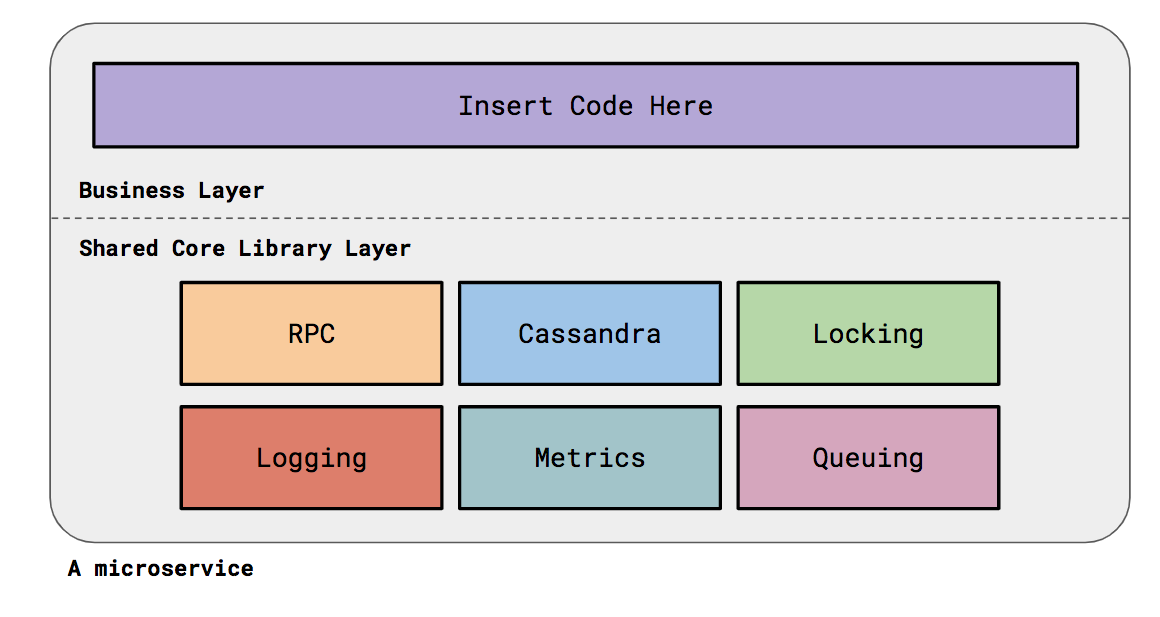Building a Banking Infrastructure with Microservices

On the whole, the goal is to make engineers autonomous as much as possible for
organising their domain into the structure of the microservices they write and
support. As a Platform Team, we provide knowledge and documentation and
tooling to support that. Each microservice has an associated owning team and
they are responsible for the health of their services. When a service moves
owners, other responsibilities like alerts and code review also move over
automatically. ... Code generation starts from the very beginning of a
service. An engineer will use a generator to create the skeleton structure of
their service. This will generate all the required folder structure as well as
write boilerplate code so things like the RPC server are well configured and
have appropriate metrics. Engineers can then define aspects like their RPC
interface and use a code generator to generate implementation stubs of their
RPC calls. Small reductions in cognitive overhead for engineers allows them to
cumulatively focus on business choices and reduces the paradox of choice. We
do find cases where engineers need to deviate. That’s absolutely okay; our
goal is not to prescribe this structure for every single service. We allow
engineers to make the choice, with the knowledge that deviations need
appropriate documentation/justification and knowledge transfer.
Cybersecurity Skills Gap Worsens, Fueled by Lack of Career Development

The fundamental causes for the skill gap are myriad, starting with a lack of
training and career-development opportunities. About 68 percent of the
cybersecurity professionals surveyed by ESG/ISSA said they don’t have a
well-defined career path, and basic growth activities, such as finding mentor,
getting basic cybersecurity certifications, taking on cybersecurity
internships and joining a professional organization, are missing steps in
their endeavors. The survey also found that many professionals start out in
IT, and find themselves working in cybersecurity without a complete skill
set. ... The COVID-19 pandemic is not helping matters on this front:
“Increasingly, lockdown has driven us all online and the training industry has
been somewhat slow to respond with engaging, practical training supported by
skilled practitioners who can share their expertise,” Steve Durbin, managing
director of the Information Security Forum, told Threatpost. “Apprenticeships,
on the job learning, backed up with support training packages are the way to
go to tackle head on a shortage that is not going to go away.”
The Top 10 Digital Transformation Trends Of 2020: A Post Covid-19 Assessment

Using big data and analytics has always been on a steady growth trajectory and
then COVID-19 exploded and made the need for data even greater. Companies and
institutions like Johns Hopkins and SAS created COVID-19 health dashboards
that compiled data from a myriad of sources to help governments and businesses
make decisions to protect citizens, employees, and other stakeholders. Now, as
businesses are in re-opening phases, we are using data and analytics for
contact tracing and to help make other decisions in the workplace. There have
been recent announcements from several big tech companies including Microsoft,
HPE, Oracle, Cisco and Salesforce focusing on developing data driven tools to
help bring employees back to work safely — some even offering it for free to
its customers. The need for data to make all business decisions has grown, but
this year, we saw data analytics being used in real time to make critical
business and life-saving decisions, and I am certain it won’t stop there. I
expect massive continued investment from companies into data and analytics
capabilities that power faster, leaner and smarter organizations in the wake
of 2020’s Global Pandemic and economic strains.
How government policies are harming the IT sector | Opinion

Thanks to a series of misplaced policy choices, the government has
systematically eroded the permitted operations of the Indian outsourcing
industry to the point where it is no longer globally competitive. Foremost
among these are the telecom regulations imposed on a category of companies
broadly known as Other Service Providers (OSPs). Anyone who provides
“application services” is an OSP and the term “application services” is
defined to mean “tele-banking, telemedicine, tele-education, tele-trading,
e-commerce, call centres, network operation centres and other IT-enabled
services”. When it was first introduced, these regulations were supposed to
apply to the traditional outsourcing industry, focusing primarily on call
centre operations. However, it has, over the years been interpreted far more
widely than originally intended. While OSPs do not require a license to
operate, they do have to comply with a number of telecom restrictions. The
central regulatory philosophy behind these restrictions is the government’s
insistence that voice calls terminated in an OSP facility over the regular
Public Switched Telephone Network (PSTN) must be kept from intermingling with
those carried over the data network.
Data science's ongoing battle to quell bias in machine learning

Data bias is tricky because it can arise from so many different things. As you
have keyed into, there should be initial considerations of how the data is
being collected and processed to see if there are operational or process
oversight fixes that exist that could prevent human bias from entering in the
data creation phase. The next thing I like to look at is data imbalances
between classes, features, etc. Oftentimes, models can be flagged as treating
one group unfairly, but the reason is there is not a large enough population
of that class to really know for certain. Obviously, we shouldn't use models
on people when there's not enough information about them to make good
decisions. ... Machine learning interpretability [is about] how transparent
model architectures are and increasing how intuitive and understandable
machine learning models can be. It is one of the components that we believe
makes up the larger picture of responsible AI. Put simply, it's really hard to
mitigate risks you don't understand, which is why this work is so critical. By
using things like feature importance, Shapley values, surrogate decision
trees, we are able to paint a really good picture of why the model came to the
conclusion it did -- and if the reason it came to that conclusion violates
regulatory rules or makes common business sense.
Integration Testing ASP.NET Core Applications - Best Practices
Compared to unit tests, this allows much more of the application code to be
tested together, which can rapidly validate the end-to-end behaviour of your
service. These are also sometimes referred to as functional tests, since the
definition of integration testing may be applied to more comprehensive
multi-service testing as well. It’s entirely possible to test your
applications in concert with their dependencies, such as databases or other
APIs they expect to call. In the course, I show how boundaries can be defined
using fakes to test your application without external dependencies, which
allows your tests to be run locally during development. Of course, you can
avoid such fakes to test with some real dependencies as well. This form of
in-memory testing can then easily be expanded to broader testing of multiple
services as part of CI/CD workflows. Producing these courses is a lot of work,
but that effort is rewarded when people view the course and hopefully leave
with new skills to apply in their work. If you have a subscription to
Pluralsight already, I hope you’ll add this course to your bookmarks for
future viewing.
How Robotic Process Automation (RPA) and digital transformation work together

RPA is not on its own an intelligent solution. As Everest Group explains in
its RPA primer, “RPA is a deterministic solution, the outcome of which is
known; used mostly for transactional activities and standardized processes.”
Some common RPA use cases include order processing, financial report
generation, IT support, and data aggregation and reconciliation. However, as
organizations proceed along their digital transformation journeys, the fact
that many RPA solutions are beginning to integrate cognitive capabilities
increases their value proposition. For example, RPA might be coupled with
intelligent character recognition (ICR) and optical character recognition
(OCR). Contact center RPA applications might incorporate natural language
processing (NLP) and natural language generation (NLG) to enable chatbots.
“These are all elements of an intelligent automation continuum that allow a
digital transformation,” Wagner says. “RPA is one piece of a lengthy continuum
of intelligent automation technologies that, used together and in an
integrated manner, can very dramatically change the operational cost and speed
of an organization while also enhancing compliance and reducing costly
errors.”
It’s not about cloud vs edge, it’s about connections

“What is wanted is a new type of networking platform that establishes a
reliable, high performance, zero trust connection across the Internet —
meaning one that will only connect an authorised device and authorised user
using an authorised application (ie ‘zero trust’),” he said. “With zero trust,
every connection is continuously assessed to identify who or what is
requesting access, have they properly authenticated, and are they authorised
to use the resource or service being requested — before any network access is
permitted. “This can be achieved using software defined networking loaded into
the edge device or embedding networking capabilities into applications with
SDKs and APIs. This eliminates the need to procure, install and commissioning
hardware. Unlike VPNs, these software-defined connections can be tightly
segmented according to company policies (policy based access), determining
which workgroups or devices can be connected, and what they can share and how.
“This suggests a new paradigm: an edge-core-cloud continuum, where apps and
services will run wherever most needed, connected via zero trust networking
access (ZTNA) capable of securing the edge to cloud continuum end to end...."
Put Value Creation at the Center of Your Transformation

The leader of any transformation effort needs to be resilient and determined
to deliver the program’s full potential. Yet that person also needs to
understand and acknowledge the needs of employees during a radical upheaval.
Sometimes leaders must be pragmatic—particularly when the company’s long-term
survival is at stake. At other times, empathy and flexibility are more
effective. One CEO brought determination and conviction to the company’s
transformation, and he was able to tamp down dissent, gossip, and negative
press. He was also willing to reverse his decisions on some matters. For
example, one cost-reduction measure was a cutback in employee travel.
Initially, the CEO told employees that they needed direct approval from him
for any travel expenses above a certain amount. However, after about a year,
he relaxed this policy after considering employees’ feedback. ...
Transformations are a proving ground for leadership teams. They can be
catalysts to long-term business success and financial performance—but
companies undergoing a transformation underperform almost as often as they
outperform. Our analysis shows that there is a systematic way to increase the
odds of success.
The sinking fortunes of the shipping box

Another surprising problem for the global manufacturing model is that shipping
has actually become less efficient, largely due to business decisions of the
shippers. Maersk, the world-leading Danish firm, continued to order ever-larger
container ships after the financial crisis, convinced that consumer demand would
quickly resume its previous growth. When it did not, the firm and its
competitors were forced to sail half-full megaships around the world. Because
the ships were several meters wider than their predecessors, the process of
removing containers took longer. And they were designed to travel more slowly to
conserve fuel. Delays became much more common, undermining trust in the
industry. Without reliable shipping, Levinson writes, firms have chosen to hold
more inventory — which flies in the face of the prevailing orthodoxy. But things
have changed. Inventories can act as a buffer when supply chains are in
distress. For firms, “minimizing production costs was no longer the sole
priority; making sure the goods were available when needed ranked just as
highly.” It seems inevitable that the coronavirus pandemic will reinforce this
drift back toward greater self-sufficiency in manufacturing.
Quote for the day:
No comments:
Post a Comment